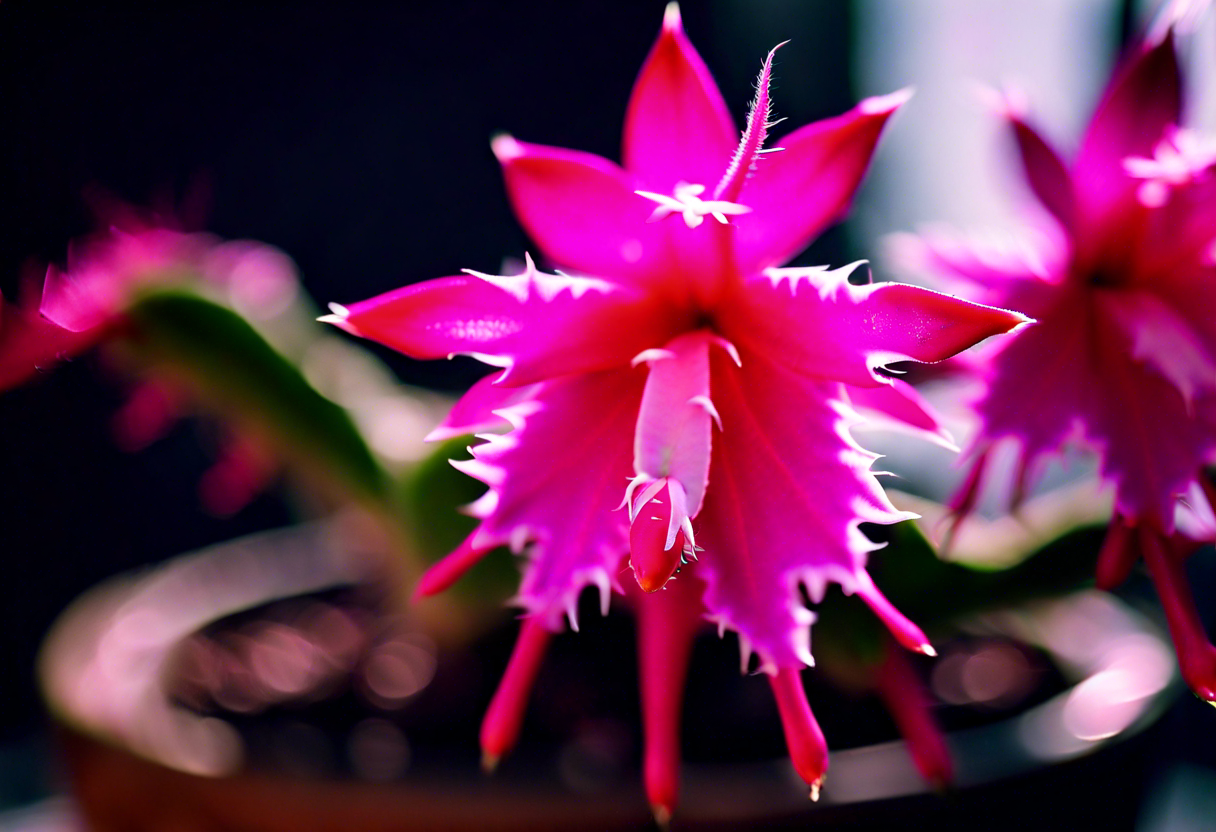Benefits of Growing Thanksgiving Cactus Indoors
Thanksgiving Cactus, scientifically known as Schlumbergera truncata, is a popular houseplant cherished for its striking blooms that typically emerge in late fall. Growing Thanksgiving Cactus indoors provides a plethora of benefits that make it a favorite among plant enthusiasts. Here are some advantages of cultivating this vibrant succulent in your home:
-
Low Maintenance: Thanksgiving Cactus is relatively easy to care for, making it an ideal choice for both experienced and novice gardeners. With proper attention to light, water, and temperature, this plant can thrive indoors with minimal effort.
-
Beautiful Blooms: One of the main attractions of Thanksgiving Cactus is its stunning flowers that come in an array of colors including pink, red, white, and orange. These colorful blooms add a touch of elegance and beauty to any indoor space, brightening up dull winter days.
-
Air Purification: Like all plants, Thanksgiving Cactus helps improve indoor air quality by absorbing carbon dioxide and releasing oxygen during photosynthesis. Having these plants around can contribute to a healthier living environment by reducing toxins in the air.
-
Longevity: With proper care, Thanksgiving Cactus can live for many years, providing you with long-lasting beauty and enjoyment. These plants have a slow growth rate and can be passed down through generations, creating a sense of continuity and tradition in your home.
-
Festive Décor: During the holiday season, Thanksgiving Cactus blooms just in time to add a festive touch to your home. Whether used as a centerpiece on the dining table or placed on a windowsill, the vibrant flowers of this plant bring a cheerful holiday spirit to any room.
-
Propagation: Thanksgiving Cactus is a plant that keeps on giving. It is easy to propagate by taking cuttings and rooting them in soil or water. This means you can share the beauty of this plant with friends and family by gifting them a piece of your beloved Thanksgiving Cactus.
Growing Thanksgiving Cactus indoors offers a range of benefits from low maintenance to beautiful blooms and air purification. Adding this plant to your indoor garden not only enhances the aesthetic appeal of your home but also contributes to a healthier and happier living space.
To learn more about caring for Thanksgiving Cactus, visit plantcaretoday.com{:target="_blank"}.
Tips for Caring for Schlumbergera truncata During the Holiday Season
As the holiday season approaches, it is essential to provide proper care for your Thanksgiving Cactus (Schlumbergera truncata) to ensure it thrives and blooms beautifully. Here are some valuable tips to help you maintain your Thanksgiving Cactus during this festive period:
1. Light and Temperature: Place your Thanksgiving Cactus in a location where it can receive bright, indirect light. Avoid direct sunlight as it can lead to sunburn on the leaves. Maintaining a temperature range between 60-70°F (15-21°C) is ideal for the plant’s growth.
2. Watering: During the holiday season, adjust your watering routine for the Thanksgiving Cactus. Allow the top inch of the soil to dry out between waterings. Overwatering can cause root rot, so it’s crucial to strike a balance and not let the soil become soggy.
3. Humidity: To provide adequate humidity for your Thanksgiving Cactus, consider using a humidifier or placing a tray filled with water and pebbles near the plant. This will help maintain the moisture levels around the plant, especially during the winter months when the air tends to be drier.
4. Fertilization: During the holiday season, your Thanksgiving Cactus may benefit from a light application of a balanced houseplant fertilizer. Be sure to dilute the fertilizer to half the recommended strength to avoid over-fertilizing the plant.
5. Flowering: To encourage blooming in your Thanksgiving Cactus during the holiday season, ensure the plant receives 12-14 hours of darkness each night. This mimics its natural light conditions and aids in the formation of flower buds.
6. Pruning: If you notice any dead or wilted segments on your Thanksgiving Cactus, gently remove them with clean pruning shears. Pruning helps the plant redirect its energy to healthy growth areas and promotes overall plant health.
By following these tips, you can ensure that your Thanksgiving Cactus remains vibrant and healthy during the holiday season, delighting you with its colorful blooms. Remember to observe your plant regularly and make adjustments to its care routine as needed to cater to its specific requirements.
Understanding the differences between Thanksgiving Cactus and Christmas Cactus
When it comes to holiday cacti, the Thanksgiving Cactus (Schlumbergera truncata) and the Christmas Cactus (Schlumbergera x buckleyi) are two popular choices that often cause confusion due to their similarities. While both plants belong to the same botanical group, there are key differences between them that set them apart.
One of the main distinguishing features between Thanksgiving Cactus and Christmas Cactus is their blooming period. Thanksgiving Cacti typically bloom earlier in the year, from late fall to early winter, usually around – you guessed it – Thanksgiving time. On the other hand, Christmas Cacti bloom later, usually from late November through December, just in time for the Christmas holiday.
Another way to tell the two plants apart is by looking at their leaf segments. Thanksgiving Cacti have more prominent, claw-like projections on the edges of their flattened stem segments, giving them a unique appearance. In contrast, Christmas Cacti have smoother and more rounded stem segments without the pointed edges.
Furthermore, the care requirements for these holiday cacti also differ slightly. Thanksgiving Cacti prefer slightly cooler temperatures and can tolerate brighter light compared to Christmas Cacti, which require warmer temperatures and indirect light to thrive. Understanding these differences is crucial for providing the right growing conditions for each plant.
In terms of flower structure, Thanksgiving Cacti typically have flowers that point sideways, whereas Christmas Cacti flowers point more upwards. The colors of the flowers can also vary between the two varieties, with Thanksgiving Cacti often showcasing shades of pink, red, and orange, while Christmas Cacti tend to have more pastel-colored blooms.
While both Thanksgiving Cactus and Christmas Cactus belong to the same plant group and share some similarities, such as their epiphytic nature and beautiful, cascading flowers, paying attention to the blooming period, leaf shape, care requirements, and flower structure can help you differentiate between the two and ensure you provide the best possible care for these festive plants.
For more information on Thanksgiving Cactus and Christmas Cactus, you can visit Gardening Know How.
Common Thanksgiving Cactus Pests and How to Prevent Them
Thanksgiving Cactus (Schlumbergera truncata) is a gorgeous plant that brightens up any indoor space during the holiday season with its vibrant blooms. However, like any plant, Thanksgiving Cactus is susceptible to pests that can damage its health and appearance. By being proactive and taking preventive measures, you can keep these common pests at bay and ensure that your Thanksgiving Cactus thrives.
One of the most common pests that can affect Thanksgiving Cactus is the spider mite. These tiny pests are barely visible to the naked eye but can cause significant damage by feeding on the plant’s sap, leading to yellowing leaves and webbing on the plant. To prevent spider mites, regularly mist your Thanksgiving Cactus to increase humidity levels, as spider mites thrive in dry conditions. If you notice signs of infestation, gently wipe the leaves with a damp cloth to remove the pests.
Another common pest that can trouble Thanksgiving Cactus is the mealybug. Mealybugs are small, soft-bodied insects that appear as white, cottony masses on the plant. They feed on the plant’s sap, causing stunted growth and yellowing leaves. To prevent mealybugs, inspect your Thanksgiving Cactus regularly, especially in the leaf axils and stems where they tend to hide. If you spot mealybugs, remove them with a cotton swab dipped in rubbing alcohol.
Aphids are another common pest that can infest Thanksgiving Cactus. These tiny insects feed on the plant’s sap, causing distorted growth and yellowing leaves. To prevent aphids, introduce natural predators like ladybugs into your home, as they feed on aphids and help keep their population in check. You can also spray your Thanksgiving Cactus with a neem oil solution to deter aphids from settling on the plant.
Fungus gnats are another nuisance that can affect Thanksgiving Cactus. These tiny black flies lay their eggs in the soil, and the larvae feed on the plant’s roots, leading to wilting and yellowing of the leaves. To prevent fungus gnats, avoid overwatering your Thanksgiving Cactus, as they thrive in moist conditions. Allow the top inch of the soil to dry out between waterings and place sticky traps near the plant to catch any adult flies.
By staying vigilant and implementing these preventive measures, you can protect your Thanksgiving Cactus from common pests and ensure that it remains healthy and beautiful throughout the holiday season.
For more information on pest control for Thanksgiving Cactus, visit Gardening Know How.
Creative Ways to Display Thanksgiving Cactus in Your Home
When it comes to showcasing your Thanksgiving Cactus (Schlumbergera truncata) in your home, there are plenty of creative ways to highlight this beautiful holiday plant. Whether you want to add a festive touch to your living space or create a stunning centerpiece for your dining table, here are some ideas to inspire you:
-
Hanging Baskets: Consider hanging your Thanksgiving Cactus in decorative baskets near windows or in cozy corners of your home. This not only adds visual interest but also keeps the plant out of reach of pets or young children.
-
Vintage Plant Stands: Place your Thanksgiving Cactus on vintage plant stands to add a touch of elegance to your decor. Opt for ornate metal stands or repurpose an old wooden stand for a shabby chic look.
-
Terrariums: Create a mini indoor garden by planting your Thanksgiving Cactus in a glass terrarium. Add decorative pebbles, moss, or mini figurines to enhance the visual appeal.
-
Seasonal Centerpiece: Transform your Thanksgiving table with a stunning centerpiece featuring your cactus. Pair it with candles, pine cones, and fall foliage for a festive display.
-
DIY Macramé Hangers: Get crafty and make your own macramé plant hangers to showcase your Thanksgiving Cactus in style. Hang them near a sunny window for an eye-catching display.
-
Tiered Plant Stand: Use a tiered plant stand to create a cascading effect with your Thanksgiving Cactus. This not only saves space but also adds a dynamic element to your indoor garden.
-
Repurposed Containers: Upcycle old teacups, mason jars, or tin cans as unique containers for your cactus. Get creative with different shapes and designs to add a personalized touch to your display.
-
Wall Shelves: Install wall shelves to create a gallery-inspired display for your Thanksgiving Cactus collection. Mix and match different sizes and heights for visual interest.
-
Fairy Lights: Add a touch of magic to your cactus display by incorporating fairy lights. The soft glow of the lights will enhance the beauty of the plant and create a cozy ambiance in your home.
-
Botanical Gallery Wall: Create a botanical gallery wall by showcasing your Thanksgiving Cactus alongside other houseplants or botanical prints. This eclectic display adds personality and charm to any room.
By incorporating these creative display ideas, you can elevate the beauty of your Thanksgiving Cactus and infuse your home with seasonal cheer. Experiment with different styles and arrangements to find the perfect way to showcase this festive plant in your living space.
For more inspiration on decorating with holiday plants, check out The Spruce for expert tips and DIY tutorials.
Conclusion
Thanksgiving Cactus (Schlumbergera truncata) into your indoor plant collection can bring a myriad of benefits, making it a delightful addition to your home decor. Its vibrant blooms, easy care requirements, and air-purifying qualities make it a popular choice among plant enthusiasts. By following some essential tips for caring for Schlumbergera truncata during the holiday season, such as providing adequate sunlight, watering appropriately, and managing temperature conditions, you can ensure that your Thanksgiving Cactus thrives and blossoms beautifully. Understanding the distinctions between Thanksgiving Cactus and Christmas Cactus, including their bloom times and leaf segments, can help you appreciate the unique characteristics of each plant and tailor your care routine accordingly.
To keep your Thanksgiving Cactus healthy and pest-free, it is crucial to be vigilant about common pests that may affect its growth, such as mealybugs and spider mites. Regularly inspecting your plant for any signs of infestation, maintaining proper humidity levels, and using natural remedies or insecticidal soaps can help prevent these pests from causing damage. Embracing creative ways to display your Thanksgiving Cactus can elevate its aesthetic appeal and brighten up your living space. Whether you choose to showcase it in a hanging basket, terrarium, or as part of a festive centerpiece, there are numerous innovative ways to enjoy the beauty of this unique plant.
By incorporating these practices into your Thanksgiving Cactus care routine, you can ensure that your plant flourishes and continues to bring joy throughout the holiday season and beyond. With proper care and attention, your Schlumbergera truncata can thrive for many years, rewarding you with its stunning blooms and vibrant foliage. Whether you are a seasoned plant enthusiast or a novice gardener, cultivating Thanksgiving Cactus can be a fulfilling and rewarding experience that enhances the beauty of your home environment.
Thanksgiving Cactus (Schlumbergera truncata) is a versatile and resilient plant that offers a host of benefits for indoor gardening enthusiasts. By following the recommended care tips, understanding the differences between Thanksgiving Cactus and Christmas Cactus, safeguarding against common pests, and exploring creative display options, you can enjoy the beauty and charm of this plant throughout the holiday season and beyond. With its striking blooms and low-maintenance requirements, Thanksgiving Cactus is a wonderful addition to any indoor plant collection, bringing color, elegance, and a touch of nature’s beauty into your home.


